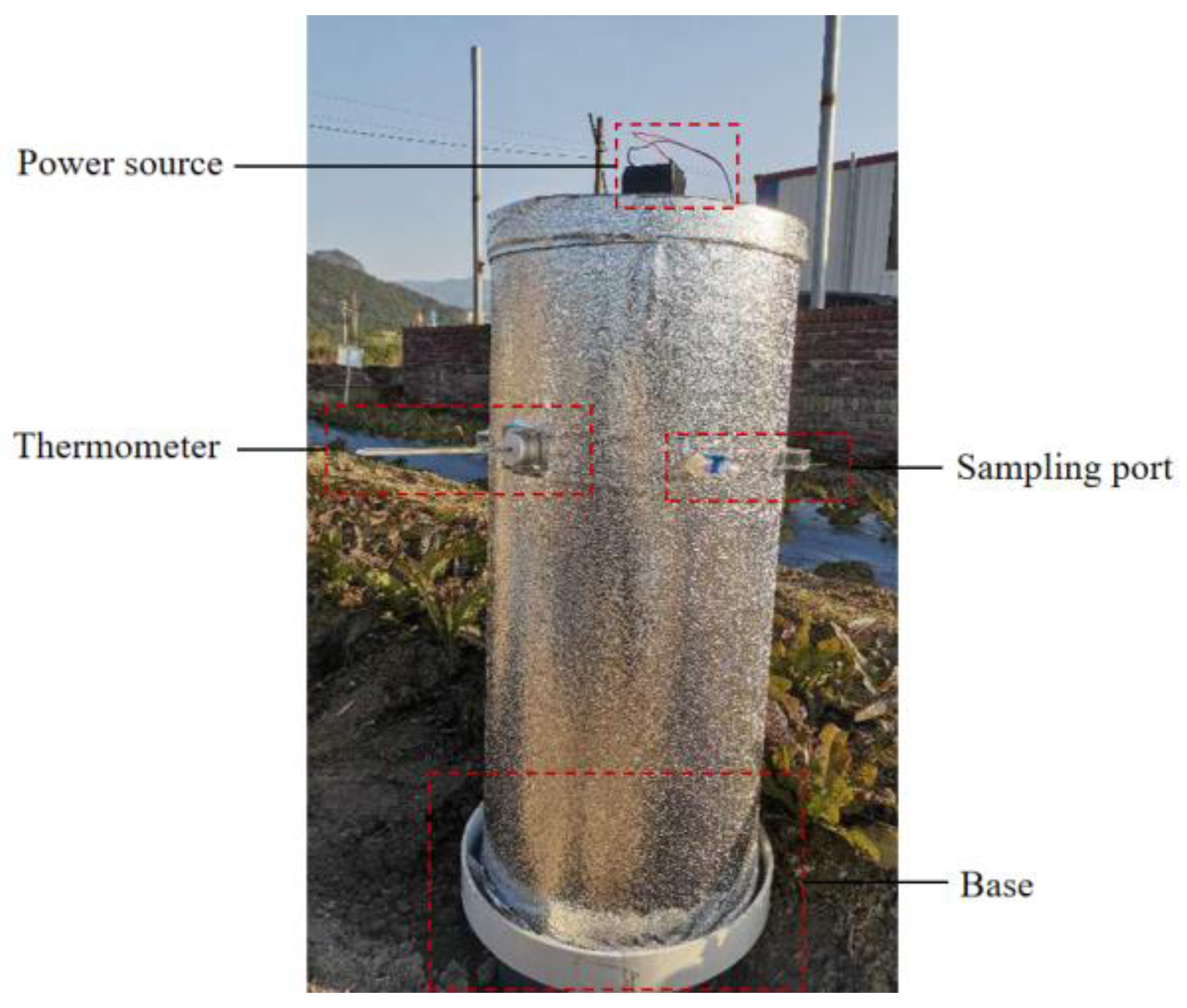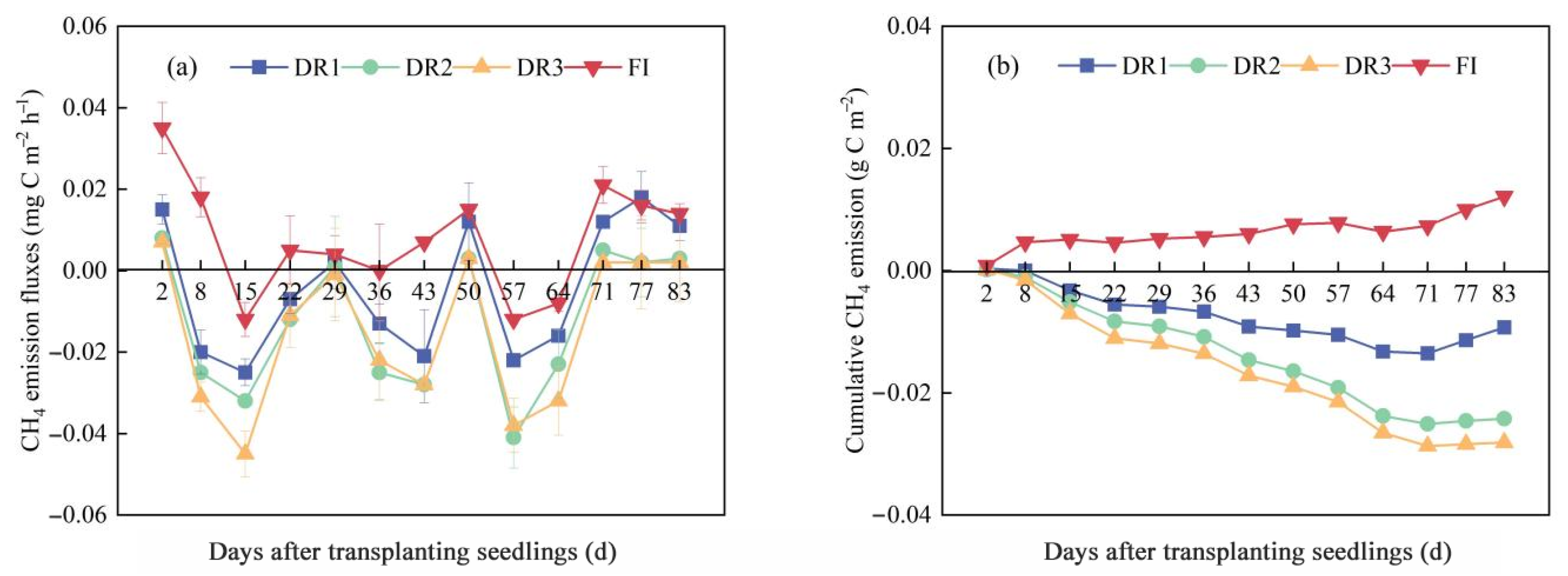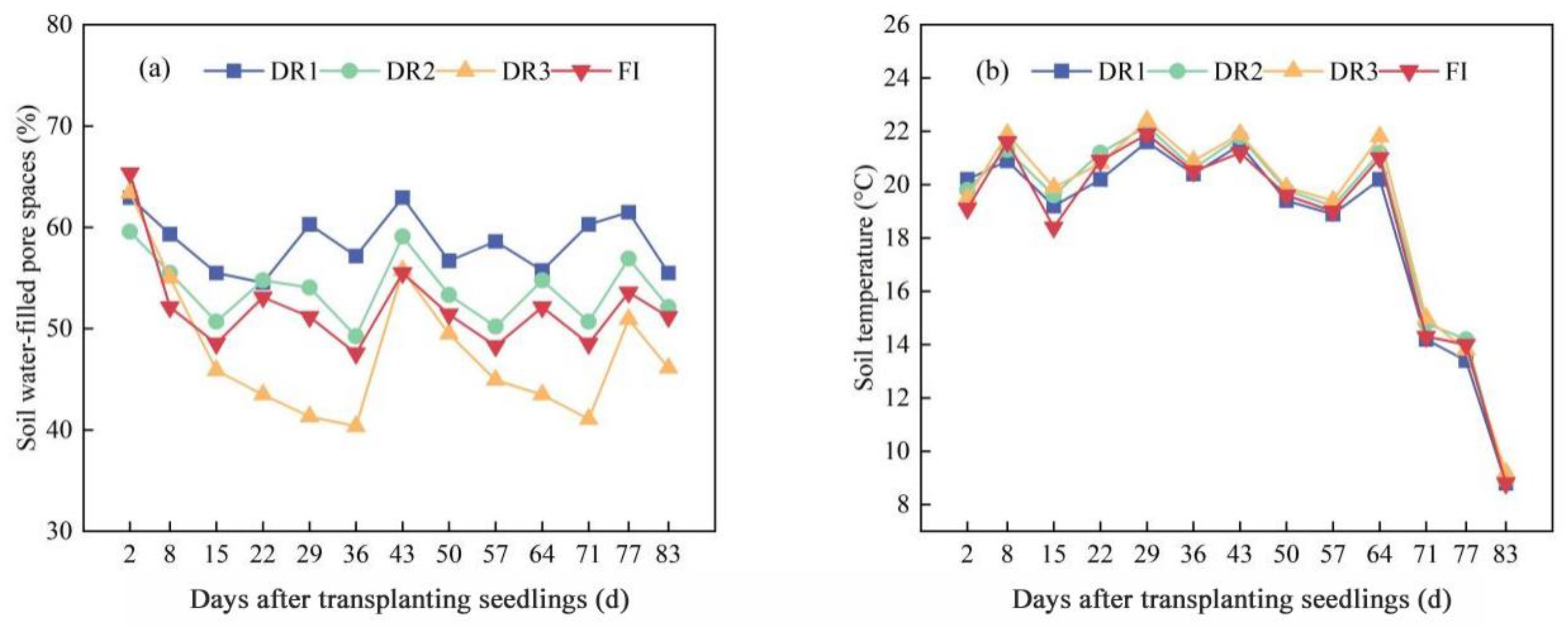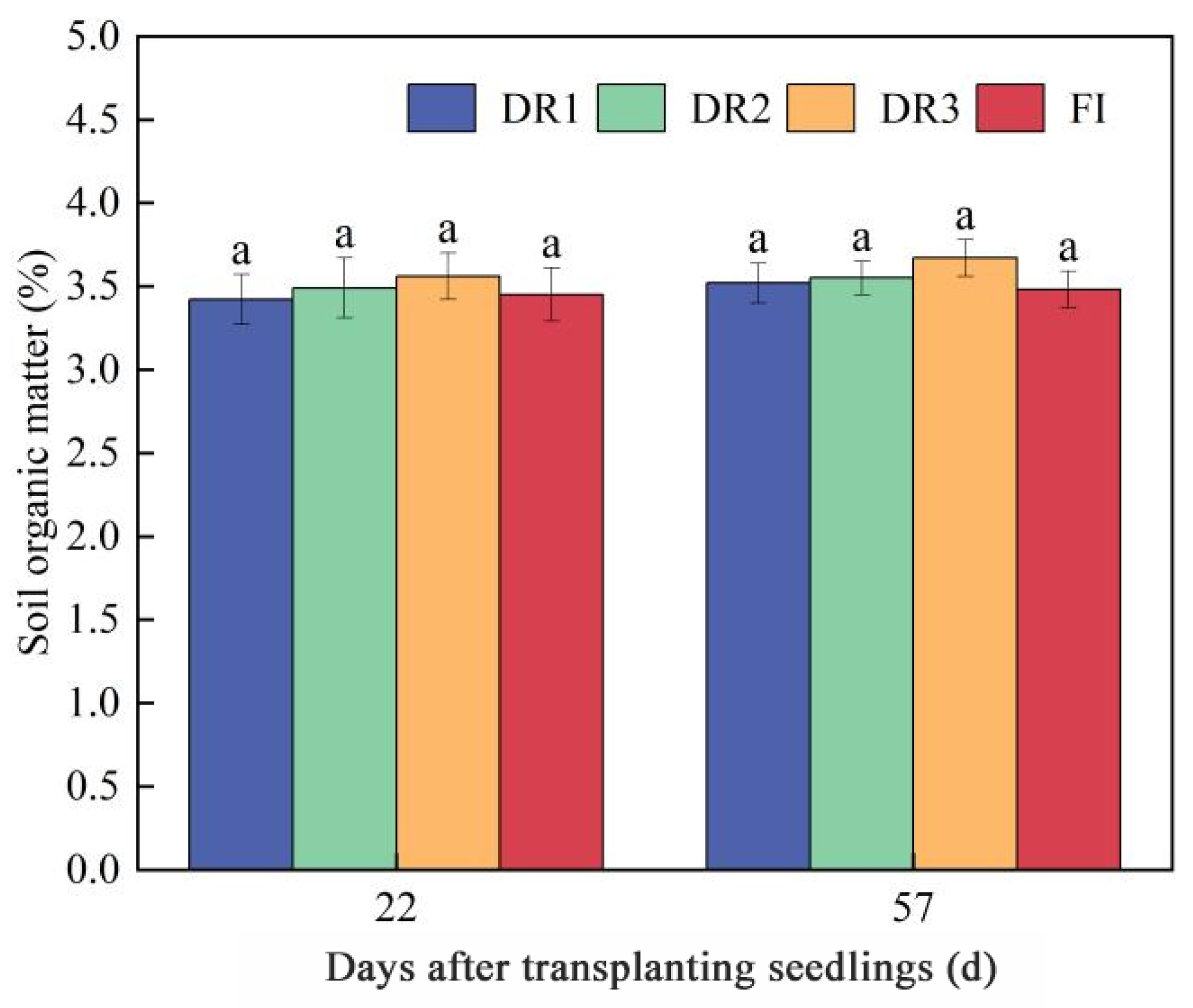Soil Gaseous Carbon Emissions from Lettuce Fields as Influenced by Different Irrigation Lower Limits and Methods
Abstract
:1. Introduction
2. Materials and Methods
2.1. Experimental Site
2.2. Experimental Design, Cropping Practices, and Treatments
2.3. Sampling and Measurement
2.4. Determination of CO2 and CH4 Emission Fluxes
2.5. Statical Analysis
3. Results
3.1. Effect of Different Irrigation Schemes on CO2 Emissions
3.2. Effect of Different Irrigation Schemes on CH4 Emissions
3.3. Effect of Different Irrigation Schemes on Soil Enzyme Activity
3.4. Effect of Different Irrigation Schemes on Soil Temperature and Moisture
3.5. Effect of Different Irrigation Schemes on Soil Organic Matter Content
3.6. Correlation Analysis between CO2/CH4 Emission and Possible Impact Factors
4. Discussion
5. Conclusions
Author Contributions
Funding
Data Availability Statement
Conflicts of Interest
References
- Hamad, A.A.A.; Ni, L.; Shaghaleh, H.; Elsadek, E.; Hamoud, Y.A. Effect of Carbon Content in Wheat Straw Biochar on N2O and CO2 Emissions and Pakchoi Productivity Under Different Soil Moisture Conditions. Sustainability 2023, 15, 5100. [Google Scholar] [CrossRef]
- Yao, Y.; Li, G.; Lu, Y.; Liu, S. Modelling the impact of climate change and tillage practices on soil CO2 emissions from dry farmland in the Loess Plateau of China. Ecol. Model. 2023, 478, 110276. [Google Scholar] [CrossRef]
- Zhang, X.; Xiao, G.; Li, H.; Wang, L.; Wu, W.; Meng, F. Mitigation of greenhouse gas emissions through optimized irrigation and nitrogen fertilization in intensively managed wheat–maize production. Sci. Rep. 2020, 10, 5907. [Google Scholar] [CrossRef]
- Liu, Y.; Tang, H.; Muhammad, A.; Huang, G. Emission mechanism and reduction countermeasures of agricultural greenhouse gases—A review. Greenh. Gases Sci. Technol. 2019, 9, 160–174. [Google Scholar] [CrossRef]
- Alfadil, A.; Xia, J.; Shaghaleh, H.; Hamoud, Y.A.; Ibrahim, J.N.; Hamad, A.A.A.; Fahad, R.; Sheteiwy, M.; Wu, T. Wheat straw biochar application improves the morphological, physiological, and yield attributes of maize and the physicochemical properties of soil under deficit irrigation and salinity stress. J. Plant Nutr. 2021, 44, 2399–2420. [Google Scholar] [CrossRef]
- Andrews, H.M.; Homyak, P.M.; Oikawa, P.Y.; Wang, J.; Jenerette, G.D. Water-conscious management strategies reduce per-yield irrigation and soil emissions of CO2, N2O, and NO in high-temperature forage cropping systems. Agric. Ecosyst. Environ. 2022, 332, 107944. [Google Scholar] [CrossRef]
- Yerli, C.; Sahin, U.; Kiziloglu, F.M.; Oztas, T.; Ors, S. Deficit irrigation with wastewater in direct sowed silage maize reduces CO2 emissions from soil by providing carbon savings. J. Water Clim. Change 2022, 13, 2837–2846. [Google Scholar] [CrossRef]
- Hou, H.; Han, Z.; Yang, Y.; Abudu, S.; Cai, H.; Li, Z. Soil CO2 emissions from summer maize fields under deficit irrigation. Environ. Sci. Pollut. Res. 2022, 27, 4442–4449. [Google Scholar] [CrossRef] [PubMed]
- Edwards, K.P.; Madramootoo, C.A.; Whalen, J.K.; Adamchuk, V.I.; Su, A.S.M.; Benslim, H. Nitrous oxide and carbon dioxide emissions from surface and subsurface drip irrigated tomato fields. Can. J. Soil Sci. 2018, 98, 389–398. [Google Scholar] [CrossRef]
- Chen, J.; Jin, Q.; Zhu, Q.; Xiao, Y.; Zhu, J.; Shao, X.; Hou, M.; Zhong, F.; Lin, C.; Zhu, L. Fate of Soil Residual Fertilizer-N-15 as Affected by Different Drip Irrigation Regimes. Water 2022, 14, 2281. [Google Scholar] [CrossRef]
- Yu, H.; Liu, Y.; Deng, Y.; Lu, G.; Yan, H.; Wang, Y. Effects of the transformation from natural alpine grassland to mixed artificial grassland on the characteristics of soil microbial community. Environ. Sci. 2023, 44, 2928–2935. (In Chinese) [Google Scholar]
- Ren, Q.; Sun, R.; Zhang, K.; Liu, Y.; Ruan, X.; Wang, Y. Soil properties, Heavy metal accumulation, and ecological risk in vegetable greenhouses of different planting years. Environ. Sci. 2022, 43, 995–1003. (In Chinese) [Google Scholar]
- Gao, Y.; Wang, S.; Wei, M.; Li, J.; Gao, Z.; Meng, L.; Yang, F. Effects of nitrogen phosphorus and potassium dosage on the yield root morphology rhizosphere microbial quantity and enzyme activity of eggplant under substrate cultivation. Sci. Agric. Sin. 2021, 54, 4623–4634. (In Chinese) [Google Scholar]
- Shaaban, M.; Khalid, M.S.; Hu, R.; Zhou, M. Effects of water regimes on soil N2O, CH4 and CO2 emissions following addition of dicyandiamide and N fertilizer. Environ. Res. 2022, 212, 113544. [Google Scholar] [CrossRef]
- Yerli, C.; Sahin, U.; Oztas, T. CO2 emission from soil in silage maize irrigated with wastewater under deficit irrigation in direct sowing practice. Agric. Water Manag. 2022, 271, 107791. [Google Scholar] [CrossRef]
- Bregaglio, S.; Mongiano, G.; Ferrara, R.M.; Ginaldi, F.; Lagomarsino, A.; Rana, G. Which are the most favourable conditions for reducing soil CO2 emissions with no-tillage? Results from a meta-analysis. Int. Soil Water Conserv. Res. 2022, 10, 497–506. [Google Scholar] [CrossRef]
- Liu, J.; Zhang, A.; Feng, H.; Zou, X.; Chen, H. Influences of different irrigation amounts on carbon sequestration in wheat-maize rotation system. Chin. J. Appl. Ecol. 2017, 28, 169–179. (In Chinese) [Google Scholar]
- Lemon, E.R. CO2 and Plants, 1st ed.; CRC Press: Boca Raton, FL, USA, 1983; pp. 67–69. [Google Scholar]
- Lv, G.; Kang, Y.; Li, L.; Wan, S. Effect of irrigation methods on root development and profile soil water uptake in winter wheat. Irrig. Sci. 2010, 28, 387–398. [Google Scholar] [CrossRef]
- Zhang, Q.; Yang, L.; Wang, J.; Luo, H.; Zhang, Y.; Zhang, W. Effects of Different Irrigation Methods and Fertilization Measures on Soil Respiration and Its Component Contributions in Cotton Field in Arid Region. Sci. Agric. Sin. 2012, 45, 2420–2430. (In Chinese) [Google Scholar]
- Guo, S.; Qi, Y.; Luo, X.; Liu, C.; Peng, Q.; Yan, Z.; Dong, Y. Effects of drip irrigation on soil CO2 and N2O emissions and their global warming potentials of spring wheat field in arid region. J. Agro-Environ. Sci. 2016, 35, 792–800. (In Chinese) [Google Scholar]
- Zhang, X.; Ye, X.; Han, B.; Li, W.; Fan, Q.; Zou, H.; Zhang, Y. Effects of irrigation methods on emissions of greenhouse gases from facilities soil. Res. Environ. Sci. 2016, 29, 1487–1496. (In Chinese) [Google Scholar]
- Wang, G.; Liang, Y.; Zhang, Q.; Jha, S.K.; Gao, Y.; Shen, X.; Sun, J.; Duan, A. Mitigated CH4 and N2O emissions and improved irrigation water use efficiency in winter wheat field with surface drip irrigation in the North China Plain. Agric. Water Manag. 2016, 163, 403–407. [Google Scholar] [CrossRef]
- Sampathkumar, T.; Pandian, B.J.; Mahimairaja, S. Soil moisture distribution and root characters as influenced by deficit irrigation through drip system in cotton-maize cropping sequence. Agric. Water Manag. 2012, 103, 43–53. [Google Scholar] [CrossRef]
- Franco-Luesma, S.; Cavero, J.; Plaza-Bonilla, D.; Cantero-Martínez, C.; Arrúe, J.L.; Álvaro-Fuentes, J. Tillage and irrigation system effects on soil carbon dioxide (CO2) and methane (CH4) emissions in a maize monoculture under Mediterranean conditions. Soil Tillage Res. 2020, 196, 104488. [Google Scholar] [CrossRef]
- Armwell, S.; Regis, C.; Marc, C.; Johan, S.; Christian, T.; Rémi, C. Long-term tillage, residue management and crop rotation impacts on N2O and CH4 emissions from two contrasting soils in sub-humid Zimbabwe. Agric. Ecosyst. Environ. 2023, 341, 108207. [Google Scholar]
- Larisha, T.; Babita, K.; Singh, S. Water management—A tool for methane mitigation from irrigated paddy fields. Sci. Total Environ. 2010, 408, 1085–1090. [Google Scholar]
- Rosacker, L.; Kieft, T. Biomass and adenylate energy charge of a grassland soil during drying. Soil Biol. Biochem. 1990, 22, 1121–1127. [Google Scholar] [CrossRef]
- Yang, X.; Jiang, B.; Yin, H.; Kang, T.; Gao, Y.; Fan, D. Methane and Nitrous Oxide Emissions in Winter Wheat Fields as Affected by Different Drainage Measure. Chin. J. Soil Sci. 2015, 46, 471–476. (In Chinese) [Google Scholar]
- Gao, H.; Zhang, W.; Peng, C.; Zhang, X.; Li, Q.; Zhu, P. Emission Characteristics of Greenhouse Gas from Maize Field of Black Soil Region Under Long-term Fertilization. J. Agric. Resour. Environ. 2017, 34, 422–430. (In Chinese) [Google Scholar]
- Wang, M.; Zhang, Z.; Lv, C.; Lin, Y. CH4 and N2O Emissions from Rice Paddy Fields and Their GWPs Reaserch in different irrigation modes in cold rice. Res. Soil Water Conserv. 2016, 23, 95–100. (In Chinese) [Google Scholar]
- Zhang, Y.; Niu, H.; Wang, S.; Wilkes, A.; Xu, K.; Wu, X. Effects of Different Irrigation Methods on Carbon Dioxide and Methane Emissions in Ningxia Vineyards. J. Irrig. Drain. 2016, 35, 17–21. (In Chinese) [Google Scholar]
- Li, Y.; Ge, Z.; Xie, L.; Li, S.; Tan, L. Effects of waterlogging and salinity increase on CO2 efflux in soil from coastal marshes. Appl. Soil Ecol. 2022, 170, 104268. [Google Scholar] [CrossRef]
- Hui, K.; Xi, B.; Tan, W.; Song, Q. Long-term application of nitrogen fertilizer alters the properties of dissolved soil organic matter and increases the accumulation of polycyclic aromatic hydrocarbons. Environ. Res. 2022, 215, 114267. [Google Scholar] [CrossRef] [PubMed]
- Zhu, Z.; Ge, T.; Liu, S.; Hu, Y.; Ye, R.; Xiao, M.; Tong, C.; Kuzyakov, Y.; Wu, J. Rice rhizodeposits affect organic matter priming in paddy soil: The role of N fertilization and plant growth for enzyme activities, CO2 and CH4 emissions. Soil Biol. Biochem. 2018, 116, 369–377. [Google Scholar] [CrossRef]
- Li, R.; Yang, H.; Tai, J. Effects of Irrigation Methods on Farmland Greenhouse Gas Emissions. J. Inn. Mong. Univ. Natl. 2020, 35, 402–407. (In Chinese) [Google Scholar]









| Treatment | During Two Stages of the Rosette and the Fleshy Stem Expansion | Total Irrigation Amount during the Growing Period (mm) | |||
|---|---|---|---|---|---|
| Irrigation Amount Each Time (mm) | Irrigation Interval (d) | Irrigation Numbers | Irrigation Amount (mm) | ||
| DR1 | 15.8 | 9.5 | 8 | 126.5 | 284.1 |
| DR2 | 23.7 | 15.2 | 5 | 118.6 | 276.2 |
| DR3 | 31.6 | 25.3 | 3 | 94.9 | 252.5 |
| FI | 23.7 | 15.2 | 5 | 118.6 | 276.2 |
| Year | Period | Growth Stages | Moisture Treatment |
|---|---|---|---|
| 2021 | September 20–September 22 | Seed germination | |
| 2021 | September 23–October 15 | Seedling | |
| 2021 | October 16–November 21 | Rosette | √ |
| 2021–2022 | November 22–January 2 | Stem expansion | √ |
| 2022 | January 3–January 6 | Harvest |
| CO2 Emission Flux | Soil Temperature | Soil Moisture | Dehydrogenase Activity | Urease Activity | Catalase Activity | Organic Matter | |
|---|---|---|---|---|---|---|---|
| CO2 emission flux | 1 | −0.608 | −0.334 | 0.466 | 0.947 ** | 0.775 * | 0.584 |
| Soil temperature | 1 | −0.630 | 0.526 | 0.796 * | 0.738 * | 0.581 | |
| Soil moisture | 1 | −0.503 | −0.381 | −0.448 | −0.613 | ||
| Dehydrogenase activity | 1 | 0.529 | 0.609 | 0.876 ** | |||
| Urease activity | 1 | 0.860 ** | 0.568 | ||||
| Catalase activity | 1 | 0.540 | |||||
| Organic matter | 1 |
| CH4 Emission Flux | Soil Temperature | Soil Moisture | Dehydrogenase Activity | Urease Activity | Catalase Activity | Organic Matter | |
|---|---|---|---|---|---|---|---|
| CH4 emission flux | 1 | −0.570 | 0.263 | −0.791 * | −0.839 ** | −0.838 ** | −0.766 |
| Soil temperature | 1 | −0.630 | 0.526 | 0.796 * | 0.738 * | 0.581 | |
| Soil moisture | 1 | −0.503 | −0.381 | −0.448 | −0.613 | ||
| Dehydrogenase activity | 1 | 0.529 | 0.609 | 0.876 ** | |||
| Urease activity | 1 | 0.860 ** | 0.568 | ||||
| Catalase activity | 1 | 0.540 | |||||
| Organic matter | 1 |
Disclaimer/Publisher’s Note: The statements, opinions and data contained in all publications are solely those of the individual author(s) and contributor(s) and not of MDPI and/or the editor(s). MDPI and/or the editor(s) disclaim responsibility for any injury to people or property resulting from any ideas, methods, instructions or products referred to in the content. |
© 2024 by the authors. Licensee MDPI, Basel, Switzerland. This article is an open access article distributed under the terms and conditions of the Creative Commons Attribution (CC BY) license (https://creativecommons.org/licenses/by/4.0/).
Share and Cite
Wang, J.; Hamoud, Y.A.; Zhu, Q.; Shaghaleh, H.; Chen, J.; Zhong, F.; Hou, M. Soil Gaseous Carbon Emissions from Lettuce Fields as Influenced by Different Irrigation Lower Limits and Methods. Agronomy 2024, 14, 563. https://doi.org/10.3390/agronomy14030563
Wang J, Hamoud YA, Zhu Q, Shaghaleh H, Chen J, Zhong F, Hou M. Soil Gaseous Carbon Emissions from Lettuce Fields as Influenced by Different Irrigation Lower Limits and Methods. Agronomy. 2024; 14(3):563. https://doi.org/10.3390/agronomy14030563
Chicago/Turabian StyleWang, Jinwei, Yousef Alhaj Hamoud, Qinyuan Zhu, Hiba Shaghaleh, Jingnan Chen, Fenglin Zhong, and Maomao Hou. 2024. "Soil Gaseous Carbon Emissions from Lettuce Fields as Influenced by Different Irrigation Lower Limits and Methods" Agronomy 14, no. 3: 563. https://doi.org/10.3390/agronomy14030563







